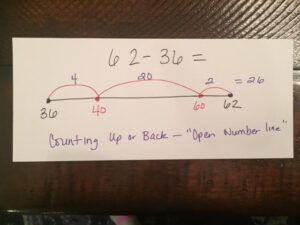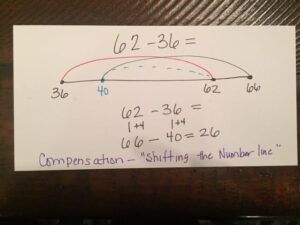According to the dictionary, subtraction is “the process of taking one number or amount away from another.” Many children use a variety of strategies to solve subtraction problems, such as counting on their fingers. As we saw with addition last week, many of the strategies children use to solve simple math problems are only useful to the point where the problems become too complex for that strategy to apply.
 At that point, older children often learn a “procedure” to get them through the “steps” in the problem. With subtraction, for example, we could take the problem of 62-36. Students might look at the problem and remember a saying their teacher taught them: “More on the floor, go next door,” meaning if the number on the bottom is larger than the one on the top, they need to borrow. So the teacher goes on: “Let’s knock on the door and ask our friend next door if I can borrow (1).” While sayings like this might help students get through their homework problems, it can also lead to simple arithmetic errors and there is no guarantee that the child actually understands the concept or procedure they are following.
At that point, older children often learn a “procedure” to get them through the “steps” in the problem. With subtraction, for example, we could take the problem of 62-36. Students might look at the problem and remember a saying their teacher taught them: “More on the floor, go next door,” meaning if the number on the bottom is larger than the one on the top, they need to borrow. So the teacher goes on: “Let’s knock on the door and ask our friend next door if I can borrow (1).” While sayings like this might help students get through their homework problems, it can also lead to simple arithmetic errors and there is no guarantee that the child actually understands the concept or procedure they are following.
We want children to use number sense to understand the concept of subtraction. In last week’s Math Mania Monday (Facebook Live broadcast), we shared two great strategies to help children truly understand subtraction. The strategies are described below, but you can also watch them in action by visiting the recording of our live broadcast!
Facebook Live: Math Mania Monday – Subtraction: Part 1
Check out the PDF Graphic Organizer that will help you keep all these strategies straight! It includes these two strategies, plus a preview of the two strategies that will be covered in Part 2 next Monday!
 Counting Up/Back: In this strategy, the students use an open number line are just what they sound like – number lines that don’t have a specified beginning or end point. Those key pieces of information are supplied by you, the problem solver, based on the problem you need to solve. Counting up/back is subtracting two numbers by counting up or back from the smaller number to larger number or the larger number to the smaller number, first by ones, then tens, and so on. There are details and examples in the video!
Counting Up/Back: In this strategy, the students use an open number line are just what they sound like – number lines that don’t have a specified beginning or end point. Those key pieces of information are supplied by you, the problem solver, based on the problem you need to solve. Counting up/back is subtracting two numbers by counting up or back from the smaller number to larger number or the larger number to the smaller number, first by ones, then tens, and so on. There are details and examples in the video!
C ompensation: Compensation is a strategy used in mental math in which you change one addend to a multiple of ten and then adjust the other addend to keep the balance. This is also known as “shifting the number line,” and we have a great example in the video!
ompensation: Compensation is a strategy used in mental math in which you change one addend to a multiple of ten and then adjust the other addend to keep the balance. This is also known as “shifting the number line,” and we have a great example in the video!
Don’t miss Subtraction Strategies: Part 2!



